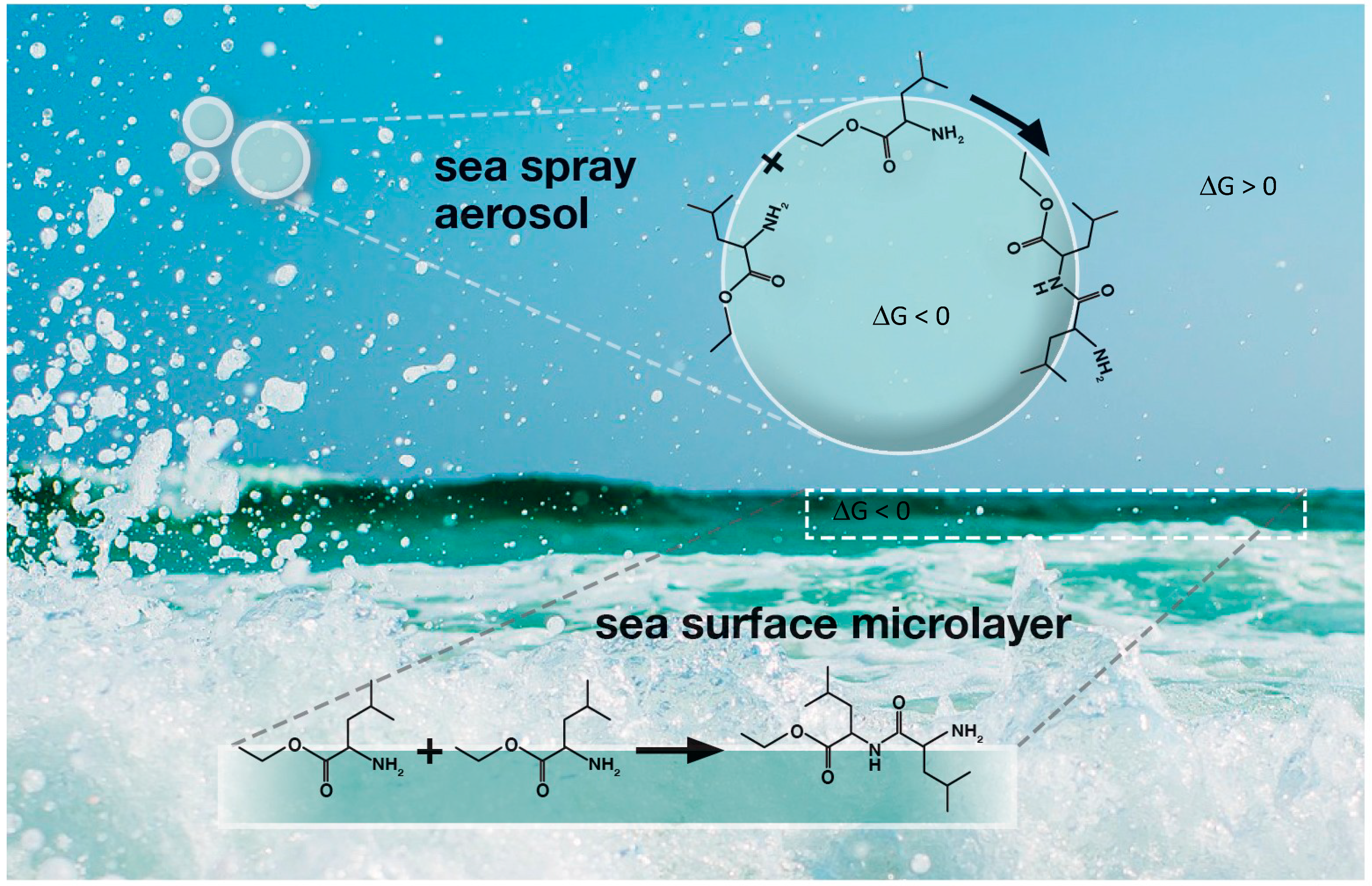Gibbs Free Energy and Reaction Rate Acceleration in and on Microdroplets
Abstract
1. Introduction
2. Methods
3. Results
4. Discussion and Conclusions
Funding
Acknowledgments
Conflicts of Interest
References
- Banerjee, S.; Gnananamani, E.; Yan, X.; Zare, R.N. Can bulk-phase reactions be accelerated in microdroplets? Analyst 2017, 142, 1399–1402. [Google Scholar] [CrossRef] [PubMed]
- Yan, X.; Bain, R.M.; Cooks, R.G. Organic reactions in Microdroplets: Reaction Acceleration Revealed by Mass Spectrometry. Angew. Chem. Int. Ed. 2016, 55, 12960–12972. [Google Scholar] [CrossRef] [PubMed]
- Fallah-Araghi, A.; Meguellati, K.; Baret, J.C.; El-Harrak, A.; Mangeat, T.; Karplus, M.; Ladame, S.; Marques, C.M.; Griffiths, A.D. Enhanced chemical synthesis at soft interfaces: A universal reaction-adsorption mechanism in microcompartments. Phys. Rev. Lett. 2014, 112, 028301. [Google Scholar] [CrossRef] [PubMed]
- Nam, I.; Lee, J.K.; Nam, H.G.; Zare, R.N. Abiotic Production of sugar phosphates and uridine ribonucleoside in aqueous microdroplets. Proc. Natl. Acad. Sci. USA 2017, 114, 12396–12400. [Google Scholar] [CrossRef]
- Vaida, V. Prebiotic phosphorylation enabled by microdroplets. Proc. Natl. Acad. Sci. USA 2017, 114, 12359–12361. [Google Scholar] [CrossRef]
- Zare, R.N. C&EN. 2018. Available online: https://www.cen.acs.org/sponsored-content/what-will-be-chemistrys-next-big-thing.html (accessed on 27 May 2018).
- Lee, J.K.; Samanta, D.; Nam, H.G.; Zare, R.N. Micrometer-sized water droplets induce spontaneous reduction. J. Am. Chem. Soc. 2019, 141, 10585–10589. [Google Scholar] [CrossRef]
- Marsh, B.M.; Iyer, K.; Cooks, R.G. Reaction Acceleration in Electrospray Droplets: Size, Distance, and Surfactant Effects. J. Am. Soc. Mass Spectrom. 2019, 30. [Google Scholar] [CrossRef]
- Tuck, A.F. Proposed empirical entropy and Gibbs energy based on observations of scale invariance in open nonequilibrium systems. J. Phys. Chem. A 2017, 121, 6620–6629. [Google Scholar] [CrossRef]
- McIntire, T.M.; Lea, A.S.; Gaspar, D.J.; Jaitty, N.; Dubowski, Y.; Li, Q.Q.; Finlayson-Pitts, B.J. Unusual aggregates from the oxidation of alkene self-assembled monolayers: A previously unrecognized mechanism for SAM ozonolysis? Phys. Chem. Chem. Phys. 2005, 7, 3605–3609. [Google Scholar] [CrossRef][Green Version]
- Zahardis, J.; LaFranchi, B.W.; Petrucci, G.A. Direct observation of polymerization in the oleic acid-ozone heterogeneous reaction system by photoelectron resonance capture ionization aerosol mass spectrometry. Atmos. Environ. 2006, 40, 1661–1670. [Google Scholar] [CrossRef]
- Reed Harris, A.E.; Pajunoja, A.; Cazaunau, M.; Gratien, A.; Pangui, E.; Monod, A.; Griffith, E.C.; Virtanen, A.; Doussin, J.-F.; Vaida, V. Multiphase photochemistry of pyruvic acid under atmospheric conditions. J. Phys. Chem. A 2017, 121, 3327–3339. [Google Scholar] [CrossRef] [PubMed]
- Griffith, E.C.; Rapf, R.J.; Shoemaker, R.K.; Carpenter, B.K.; Vaida, V. Photoinitiated synthesis of self-assembled vesicles. J. Am. Chem. Soc. 2014, 136, 3784–3787. [Google Scholar] [CrossRef] [PubMed]
- Donaldson, D.J.; Anderson, D. Adsorption of atmospheric gases at the air-water interface. 2. C1–C4 alcohols, acids and acetone. J. Phys. Chem. A 1999, 103, 871–876. [Google Scholar] [CrossRef]
- Donaldson, D.J.; Tuck, A.F.; Vaida, V. Spontaneous fission of atmospheric aerosol particles. Phys. Chem. Chem. Phys. 2001, 3, 5270–5273. [Google Scholar] [CrossRef]
- Donaldson, D.J.; Tuck, A.F.; Vaida, V. The asymmetry of organic aerosol fission and prebiotic chemistry. Orig. Life Evol. Biosph. 2002, 32, 237–245. [Google Scholar] [CrossRef]
- Tuck, A. The role of atmospheric aerosols in the origin of life. Surv. Geophys. 2002, 23, 379–409. [Google Scholar] [CrossRef]
- Griffith, E.C.; Vaida, V. In situ observation of peptide bond formation at the water-air interface. Proc. Natl. Acad. Sci. USA 2012, 109, 15697–15701. [Google Scholar] [CrossRef]
- Griffith, E.C.; Tuck, A.F.; Vaida, V. Ocean-Atmosphere Interactions in the Emergence of Complexity in Simple Chemical Systems. Acc. Chem. Res. 2012, 45, 2106–2113. [Google Scholar] [CrossRef]
- Dobson, C.M.; Ellison, G.B.; Tuck, A.F.; Vaida, V. Atmospheric aerosols as prebiotic chemical reactors. Proc. Natl. Acad. Sci. USA 2000, 97, 11864–11868. [Google Scholar] [CrossRef]
- Saha, R.; Pohorille, A.; Chen, I.A. Molecular crowding and early evolution. Orig. Life Evol. Biosph. 2014, 44, 319–324. [Google Scholar] [CrossRef]
- Liu, X.; Wang, S.Y.; Wang, J. A statistical feature of Hurst exponents of essential genes in bacterial genomes. Integr. Biol. 2012, 4, 93–98. [Google Scholar] [CrossRef] [PubMed]
- IPCC. Climate Change 2013: The Physical Science Basis. In Contribution of Working Group I to the Fifth Assessment Report of the Intergovernmental Panel on Climate Change; IPCC: Geneva, Switzerland, 2007; Chapters 7 and 8; pp. 571–740. [Google Scholar]
- Rapf, R.J.; Vaida, V. Sunlight as an energetic driver in the synthesis of molecules necessary for life. Phys. Chem. Chem. Phys. 2016, 18, 20067–20084. [Google Scholar] [CrossRef] [PubMed]
- Zhou, Z.; Yan, X.; Lai, Y.-H.; Zare, R.N. Fluorescence polarization anisotropy in microdroplets. J. Phys. Chem. Lett. 2018, 9, 2928–2932. [Google Scholar] [CrossRef] [PubMed]
- Kadau, K.; Barber, J.L.; Germann, T.C.; Alder, B.J. Scaling of atomistic fluid dynamics simulations. Phys. Rev. E 2008, 78, 045301. [Google Scholar] [CrossRef] [PubMed]
- Needleman, D.; Shelley, M. The stormy fluid dynamics of the living cell. Phys. Today 2019, 72, 32–39. [Google Scholar] [CrossRef]
- Krapf, D.; Metzler, R. Strange interfacial molecular dynamics. Phys. Today 2019, 72, 48–55. [Google Scholar] [CrossRef]
- Lovejoy, S.; Schertzer, D. The Weather and Climate: Emergent Laws and Multifractal Cascades; Cambridge University Press: Cambridge, UK, 2013; ISBN 978-1-107-01898-3. [Google Scholar]
- Alder, B.J.; Wainwright, T.E. Decay of the velocity autocorrelation function. Phys. Rev. A At. Mol. Opt. Phys. 1970, 1, 18–21. [Google Scholar] [CrossRef]

© 2019 by the author. Licensee MDPI, Basel, Switzerland. This article is an open access article distributed under the terms and conditions of the Creative Commons Attribution (CC BY) license (http://creativecommons.org/licenses/by/4.0/).
Share and Cite
Tuck, A.F. Gibbs Free Energy and Reaction Rate Acceleration in and on Microdroplets. Entropy 2019, 21, 1044. https://doi.org/10.3390/e21111044
Tuck AF. Gibbs Free Energy and Reaction Rate Acceleration in and on Microdroplets. Entropy. 2019; 21(11):1044. https://doi.org/10.3390/e21111044
Chicago/Turabian StyleTuck, Adrian F. 2019. "Gibbs Free Energy and Reaction Rate Acceleration in and on Microdroplets" Entropy 21, no. 11: 1044. https://doi.org/10.3390/e21111044
APA StyleTuck, A. F. (2019). Gibbs Free Energy and Reaction Rate Acceleration in and on Microdroplets. Entropy, 21(11), 1044. https://doi.org/10.3390/e21111044




